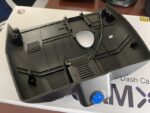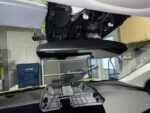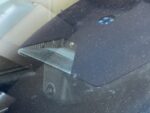I’ve been really happy with the FITCAMX dash cam in my RAV4. When my wife got her EV6 last year there wasn’t a similar model available so I ended up getting her the Garmin Mini 2 (which apparently I never wrote about here), wired into her rearview mirror housing with a Dongar USB power adapter. Since I didn’t want to use the adhesive mount on her windshield, I used a suction cup mount which meant the camera was mounted a little lower on the glass (below the mirror housing) and thus more in the line-of-sight of the driver. This setup was fine, it just didn’t have that “factory installed” look and occasionally the suction cup would become unstuck in the Florida heat so she’d come back to the car to find the dash cam dangling from its power cable, and putting up a sunshield was also a little problematic.
Well, recently over on the EV6 Forums I saw that the FITCAMX was now available for the EV6 so I immediately ordered one (direct, so it came from China).
Just like the model for my RAV4, installation was easy and took maybe 15 minutes. I just had to slide off the plastic camera housing behind the rearview mirror, remove the Dongar adapter I had installed for the Mini 2 and plug in the Fitcam’s wiring harness instead, and then snap the whole thing back together. The end result is a great-looking camera that seems like it was factory-installed. Since this setup is nearly identical to the model in my RAV4, I’m going to repeat a lot of the same stuff now …
- unboxing
- installation (wiring)
- before and after
- installed
- mobile app
With the hardware installation done, the next step is software: I connected my iPhone to the WiFi network being broadcast by the camera, then launched the FITCAMX app. From the app you can view a live display of the camera, view recordings and snapshots, and change the settings. I made some minor changes like the wireless network name and password and increased the resolution to the max 3840×2160 (4K). One thing to be aware of: when you go into the settings area of the app, the camera pauses recording (presumably since you may change things like video resolution or something that might require a restart). If you don’t remember to exit settings and go back to the “live” camera view and just exit the app, the camera will remain in a paused state and nothing will be recorded until it’s either powered off or you go back into the app. I discovered this by accident and lost a whole drive’s worth of video and snapshots while I was testing.
The dash cam turns on and off with the car, but a physical power button also allows you to turn it on and off if you want (otherwise, it’s always recording). There’s also a “camera” button that will take a still photo (and mark the currently recording video as “read-only” so it won’t get overwritten). A slot on the side houses the included 64mb microSD card, but I replaced it with a 128gb one from Lexar. At max resolution, a 3-minute clip takes up about 530mb so the larger card accomodates about 12 hours of continuous footage (at 2560×1440, the 3-minute file size was 332mb). You can set the clips to be longer and also have the old ones be automatically overwritten when the card is full. The dash cam also has a “G-force” sensor meant to detect collisions. This will “lock” the current video recording to prevent it from being overwritten. I also discovered there’s no file size difference with audio or off. There’s always a 63kbps mono track being recorded so apparently the settings to turn off audio just mute the microphone. I don’t need to hear any in-car conversations so I’ve turned off the audio (one nice feature of the Garmin Mini 2 was a physical button to toggle audio recording … with the Fitcam you can only do that in the app).
You can review and download photos and videos using the mobile app (if you connect your phone to the dash cam’s wireless network). I imagine it would take a while to download the video clips, over WiFi so I find it easier to just pop out the microSD card, plug it into my computer, and grab them that way. You’ll find a Movies, Photos, and RO folder (“read-only” which contains any of the locked videos from the G-force sensor or from when you pressed the physical snapshot button). This is a Chinese product and it’s clear the company is not US-based and the manuals and app are not written in English originally. There are a lot of misspellings and odd turns of phrase like “delete successed” or “I See” instead of “OK”. But the quality of the product, price, final installation, and footage itself is worth it. Here’s a sample video I took showing day and night drives:
Like the model in my RAV4, I wish the lens were slightly closer to the windshield which would avoid the reflections of the dashboard at the bottom of the frame, but that’s a pretty minor nitpick.
I did have one problem with this model of FITCAMX that I did not experience with my other one: recordings were ending 10-15 seconds before I turned off the EV6. For example, the video would show me turning into my driveway, but end before I pulled all the way into the garage. This was happening pretty consistently so I opened a support ticket with Fitcam and supplied them with the camera details, firmware version, and sample videos. They sent me a newer firmware to try and that resolved the issue. According to what they told me: “Since the rearview mirror will have no power for a moment when the car is turned off, this situation will cause the MP4 to not be saved. The advantage of the TS format is that it can save the last video when the power is off. So we solved this problem by changing the video format to TS.” So now the files in the Movie folder on the microSD card have a .ts extension but they still play fine in the app and through VLC on my PC and are still the same quality/size as before.





Here’s a good video review from someone else over on the EV6 forums: